Evaluation of Measurement Strategy for Track Side Monitoring of Railway Wheels
Abstract
1. Introduction
2. Wheel Profiles and Wheel Parameters
- Flange height Sh: vertical distance (in mm) from the nominal running circle (70 mm from the flange back) to the top of the flange
- Flange width Sd: lateral distance (in mm) between the flange back and the flange face measured at a height of 10 mm up from the nominal running circle
- Flange slope qR: lateral distance between the flange face position measured at a height of 10 mm up to 2 mm below the top of the flange
- Tread hollowing: difference in radius between the smallest radius of the tread (close to the running band) and the largest radius close to the field side
3. Methodology
3.1. In-Workshop Measurements
3.2. Wayside Measurements
4. Results and Discussion
5. Conclusions
Author Contributions
Funding
Institutional Review Board Statement
Informed Consent Statement
Data Availability Statement
Conflicts of Interest
References
- European Commission. Roadmap to a Single European Transport Area: Towards a Competitive and Resource Efficient Transport System: White Paper; European Commission: Brussels, Belgium, 2011. [Google Scholar]
- European Commission. Transport in the European Union: Current Trends and Issues; Directorate-General for Mobility and Transport (DG MOVE) Mobility and Transport March 2019; European Commission: Brussels, Belgium, 2018. [Google Scholar]
- Trafikverket. The Swedish Transport Administration Annual Report; Swedish Transport Administration: Borlänge, Sweden, 2016. [Google Scholar]
- Asplund, M. Wayside Condition Monitoring System for Railway Wheel Profiles. Ph.D. Thesis, Luleå University of Technology, Lulea, Sweden, 2016. [Google Scholar]
- Söderholm, P.; Norrbin, P. Risk-based dependability approach to maintenance performance measurement. J. Qual. Maint. Eng. 2013, 19, 316–329. [Google Scholar] [CrossRef]
- Asplund, M.; Rantatalo, M. Evaluation of wheel profile measurements by means of the contact-point function for the wheel–rail interface. Proc. Inst. Mech. Eng. Part F J. Rail Rapid Transit 2017, 232, 1225–1239. [Google Scholar] [CrossRef]
- Lewis, R.; Olofsson, U. Wheel-Rail Interface Handbook; Elsevier: Amsterdam, The Netherlands, 2009. [Google Scholar]
- Chandran, P. Train Based Automated Inspection for Railway Fastening System. Ph.D. Thesis, Luleå University of Technology, Lulea, Sweden, 2022. [Google Scholar]
- Ward, C.P.; Goodall, R.M.; Dixon, R. Wheel-rail profile condition monitoring. In Proceedings of the UKACC International Conference on Control 2010, Coventry, UK, 7–10 September 2010. [Google Scholar]
- Chen, Y.; Li, Y.; Niu, G.; Zuo, M. Offline and Online Measurement of the Geometries of Train Wheelsets: A Review. IEEE Trans. Instrum. Meas. 2022, 71, 1–15. [Google Scholar] [CrossRef]
- Nielsen, J.; Johansson, A. Out-of-round railway wheels—A literature survey. Proc. Inst. Mech. Eng. Part F J. Rail Rapid Transit 2000, 214, 79–91. [Google Scholar] [CrossRef]
- Peng, J.; Gao, X.; Zhang, Y.; Wang, Z.; Peng, C.; Tan, Y.; Yang, K.; Zhao, B. An ultrasonic technology study for subsurface defect in railway wheel tread. In Proceedings of the 11th European Conference on Non-Destructive Testing (ECNDT), Prague, Czech Republic, 6–10 October 2014. [Google Scholar]
- Asplund, M.; Palo, M.; Famurewa, S.M.; Rantatalo, M. A study of railway wheel profile parameters used as indicators of an increased risk of wheel defects. Proc. Inst. Mech. Eng. Part F J. Rail Rapid Transit 2014, 230, 323–334. [Google Scholar] [CrossRef]
- Polach, O. Wheel profile design for target conicity and wide tread wear spreading. Wear 2011, 271, 195–202. [Google Scholar] [CrossRef]
- Chandran, P.; Thierry, F.; Odelius, J.; Famurewa, S.M.; Lind, H.; Rantatalo, M. Supervised machine learning approach for detecting missing clamps in rail fastening system from differential eddy current measurements. Appl. Sci. 2021, 11, 4018. [Google Scholar] [CrossRef]
- Chandran, P.; Thiery, F.; Odelius, J.; Lind, H.; Rantatalo, M. Unsupervised Machine Learning for Missing Clamp Detection from an In-Service Train Using Differential Eddy Current Sensor. Sustainability 2022, 14, 1035. [Google Scholar] [CrossRef]
- Palo, M.; Schunnesson, H.; Kumar, U.; Larsson-Kråik, P.-O.; Galar, D. Rolling stock condition monitoring using wheel/rail forces. Insight Non-Destr. Test. Cond. Monit. 2012, 54, 451–455. [Google Scholar] [CrossRef]
- Lin, J.; Asplund, M.; Parida, A. Reliability analysis for degradation of locomotive wheels using parametric bayesian approach. Qual. Reliab. Eng. Int. 2013, 30, 657–667. [Google Scholar] [CrossRef]
- Alemi, A.; Corman, F.; Lodewijks, G. Condition monitoring approaches for the detection of railway wheel defects. Proc. Inst. Mech. Eng. Part F J. Rail Rapid Transit 2016, 231, 961–981. [Google Scholar] [CrossRef]
- Pau, M. Ultrasonic waves for effective assessment of wheel-rail contact anomalies. Proc. Inst. Mech. Eng. Part F J. Rail Rapid Transit 2005, 219, 79–90. [Google Scholar] [CrossRef]
- Pohl, R.; Erhard, A.; Montag, H.-J.; Thomas, H.-M.; Wüstenberg, H. NDT techniques for railroad wheel and gauge corner inspection. NDT E Int. 2004, 37, 89–94. [Google Scholar] [CrossRef]
- Verkhoglyad, A.G.; Kuropyatnik, I.N.; Bazovkin, V.M.; Kuryshev, G.L. Infrared diagnostics of cracks in railway carriage wheels. Russ. J. Nondestruct. Test. 2008, 44, 664–668. [Google Scholar] [CrossRef]
- Kwon, S.J.; Seo, J.W.; Lee, D.H.; You, W.J. Detection of sub-surface crack in railway wheel using a new sensing system. In Proceedings of the Nondestructive Characterization for Composite Materials, Aerospace Engineering, Civil Infrastructure, and Homeland Security 2011, San Diego, CA, USA, 7–10 March 2011. [Google Scholar]
- Żurek, Z.H. Magnetic monitoring of the fatigue process of the rim material of railway wheel sets. NDT E Int. 2006, 39, 675–679. [Google Scholar] [CrossRef]
- Hwang, J.; Lee, J.; Kwon, S. The application of a differential-type Hall sensors array to the nondestructive testing of express train wheels. NDT E Int. 2009, 42, 34–41. [Google Scholar] [CrossRef]
- Frankenstein, B.; Hentschel, D.; Pridoehl, E.; Schubert, F. Hollow shaft integrated health monitoring system for railroad wheels. In Proceedings of the Advanced Sensor Technologies for Nondestructive Evaluation and Structural Health Monitoring, San Diego, CA, USA, 8–10 March 2005. [Google Scholar]
- Liang, B.; Iwnicki, S.; Zhao, Y.; Crosbee, D. Railway wheel-flat and rail surface defect modelling and analysis by time–frequency techniques. Veh. Syst. Dyn. 2013, 51, 1403–1421. [Google Scholar] [CrossRef]
- Dwyer-Joyce, R.S.; Yao, C.; Lewis, R.; Brunskill, H. An ultrasonic sensor for monitoring wheel flange/rail gauge corner contact. Proc. Inst. Mech. Eng. Part F J. Rail Rapid Transit 2013, 227, 188–195. [Google Scholar] [CrossRef]
- Liang, B.; Iwnicki, S.; Ball, A.E.; Young, A. Adaptive noise cancelling and time–frequency techniques for rail surface defect detection. Mech. Syst. Signal Process. 2014, 54–55, 41–51. [Google Scholar] [CrossRef]
- Jia, S.; Dhanasekar, M. Detection of rail wheel flats using wavelet approaches. Struct. Health Monit. 2007, 6, 121–131. [Google Scholar] [CrossRef]
- Matsumoto, A.; Sato, Y.; Ohno, H.; Tomeoka, M.; Matsumoto, K.; Kurihara, J.; Ogino, T.; Tanimoto, M.; Kishimoto, Y.; Sato, Y.; et al. A new measuring method of wheel–rail contact forces and related considerations. Wear 2008, 265, 1518–1525. [Google Scholar] [CrossRef]
- Matsumoto, A.; Sato, Y.; Ohno, H.; Shimizu, M.; Kurihara, J.; Saitou, T.; Michitsuji, Y.; Matsui, R.; Tanimoto, M.; Mizuno, M.-A. Actual states of wheel/rail contact forces and friction on sharp curves—Continuous monitoring from in-service trains and numerical simulations. Wear 2014, 314, 189–197. [Google Scholar] [CrossRef]
- Stratman, B.; Liu, Y.; Mahadevan, S. Structural health monitoring of railroad wheels using wheel impact load detectors. J. Fail. Anal. Prev. 2007, 7, 218–225. [Google Scholar] [CrossRef]
- Johansson, A.; Nielsen, J. Out-of-round railway wheels—Wheel-rail contact forces and track response derived from field tests and numerical simulations. Proc. Inst. Mech. Eng. Part F J. Rail Rapid Transit 2003, 217, 135–146. [Google Scholar] [CrossRef]
- Wei, C.; Xin, Q.; Chung, W.H.; Liu, S.-Y.; Tam, H.-Y.; Ho, S.L. Real-time train wheel condition monitoring by fiber Bragg grating sensors. Int. J. Distrib. Sens. Netw. 2011, 8, 409048. [Google Scholar] [CrossRef]
- Filograno, M.L.; Corredera, P.; Gonzalez-Herraez, M.; Rodríguez-Plaza, M.; Andrés-Alguacil, A. Wheel flat detection in high-speed railway systems using fiber Bragg gratings. IEEE Sens. J. 2013, 13, 4808–4816. [Google Scholar] [CrossRef]
- Brizuela, J.; Fritsch, C.; Ibáñez, A. Railway wheel-flat detection and measurement by ultrasound. Transp. Res. Part C Emerg. Technol. 2011, 19, 975–984. [Google Scholar] [CrossRef]
- Salzburger, H.J.; Schuppmann, M.; Li, W.; Xiaorong, G. In-motion ultrasonic testing of the tread of high-speed railway wheels using the inspection system AUROPA III. Insight Non-Destr. Test. Cond. Monit. 2009, 51, 370–372. [Google Scholar] [CrossRef]
- Belotti, V.; Crenna, F.; Michelini, R.C.; Rossi, G.B. Wheel-flat diagnostic tool via wavelet transform. Mech. Syst. Signal Process. 2006, 20, 1953–1966. [Google Scholar] [CrossRef]
- Lee, M.L.; Chiu, W.K. Determination of railway vertical wheel impact magnitudes: Field trials. Struct. Health Monit. 2007, 6, 49–65. [Google Scholar] [CrossRef]
- Thakkar, N.; Steel, J.A.; Reuben, R.; Knabe, G.; Dixon, D.; Shanks, R. Monitoring of Rail-Wheel Interaction Using Acoustic Emission (AE). Adv. Mater. Res. 2006, 13–14, 161–168. [Google Scholar] [CrossRef]
- Kenderian, S.; Djordjevic, B.B.; Cerniglia, D.; Garcia, G. Dynamic railroad inspection using the laser-air hybrid ultrasonic technique. Insight Non-Destr. Test. Cond. Monit. 2006, 48, 336–341. [Google Scholar] [CrossRef]
- Frohling, R.D. Analysis of asymmetric wheel profile wear and its consequences. Veh. Syst. Dyn. 2006, 44, 590–600. [Google Scholar] [CrossRef]
- Al-Refaie, A.; Bata, N. Evaluating measurement and process capabilities by GR&R with four quality measures. Measurement 2010, 43, 842–851. [Google Scholar] [CrossRef]
- SS-EN 15313; Railway Applications-In-Service Wheelset Operation Requirements-In-Service and Off-Vehicle Wheelset Maintenance. European Committee for Standardization: Brussels, Belgium, 2010.
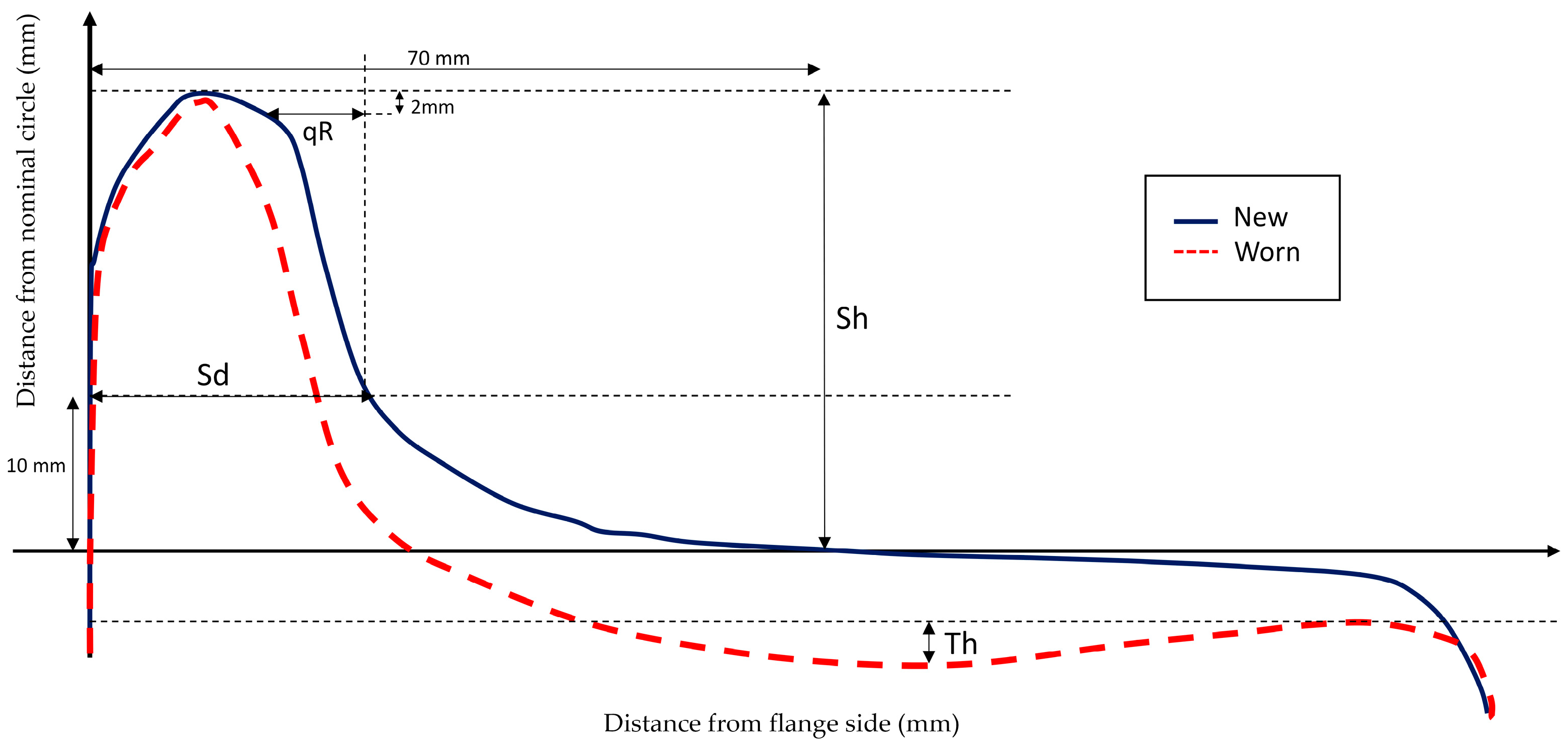

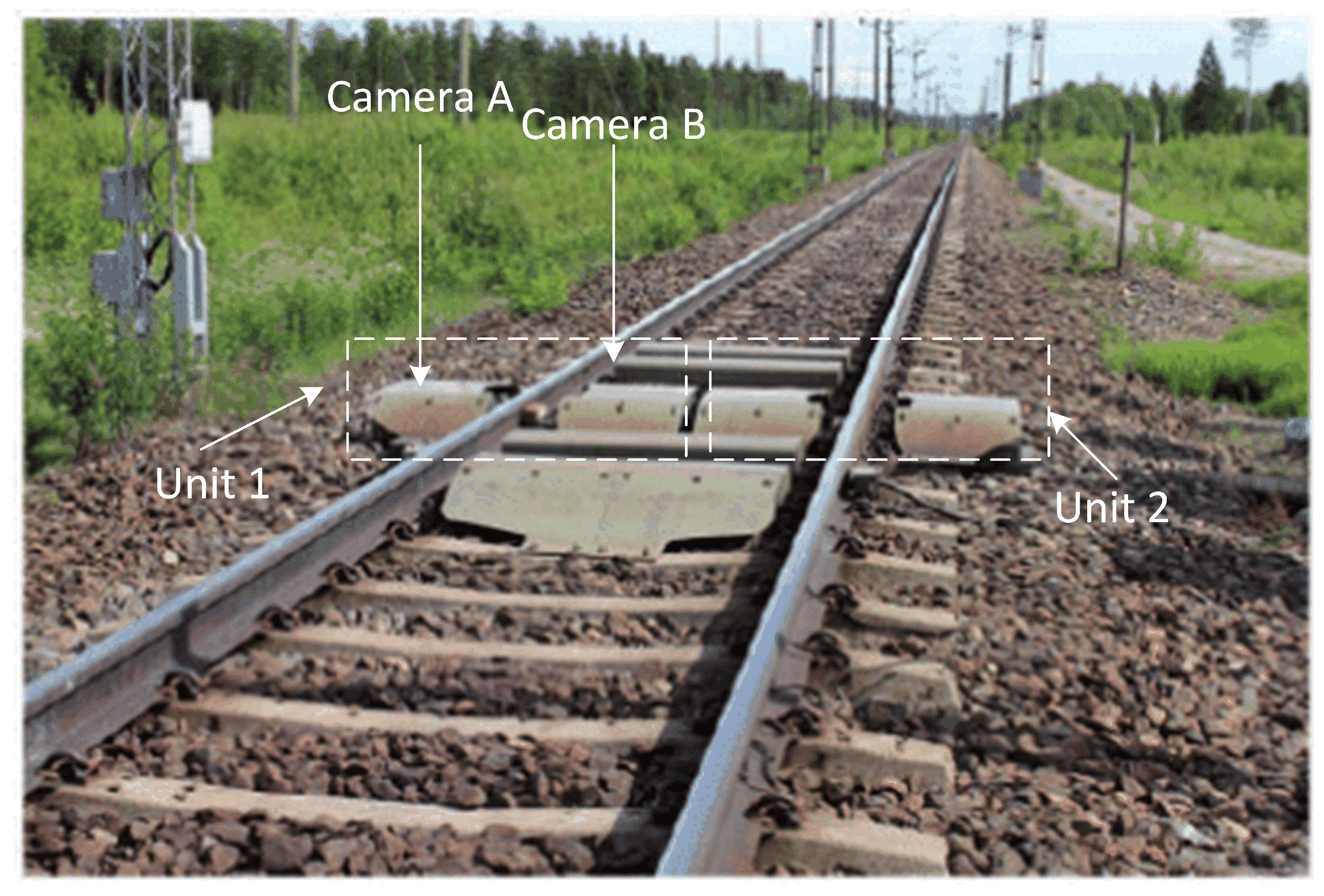
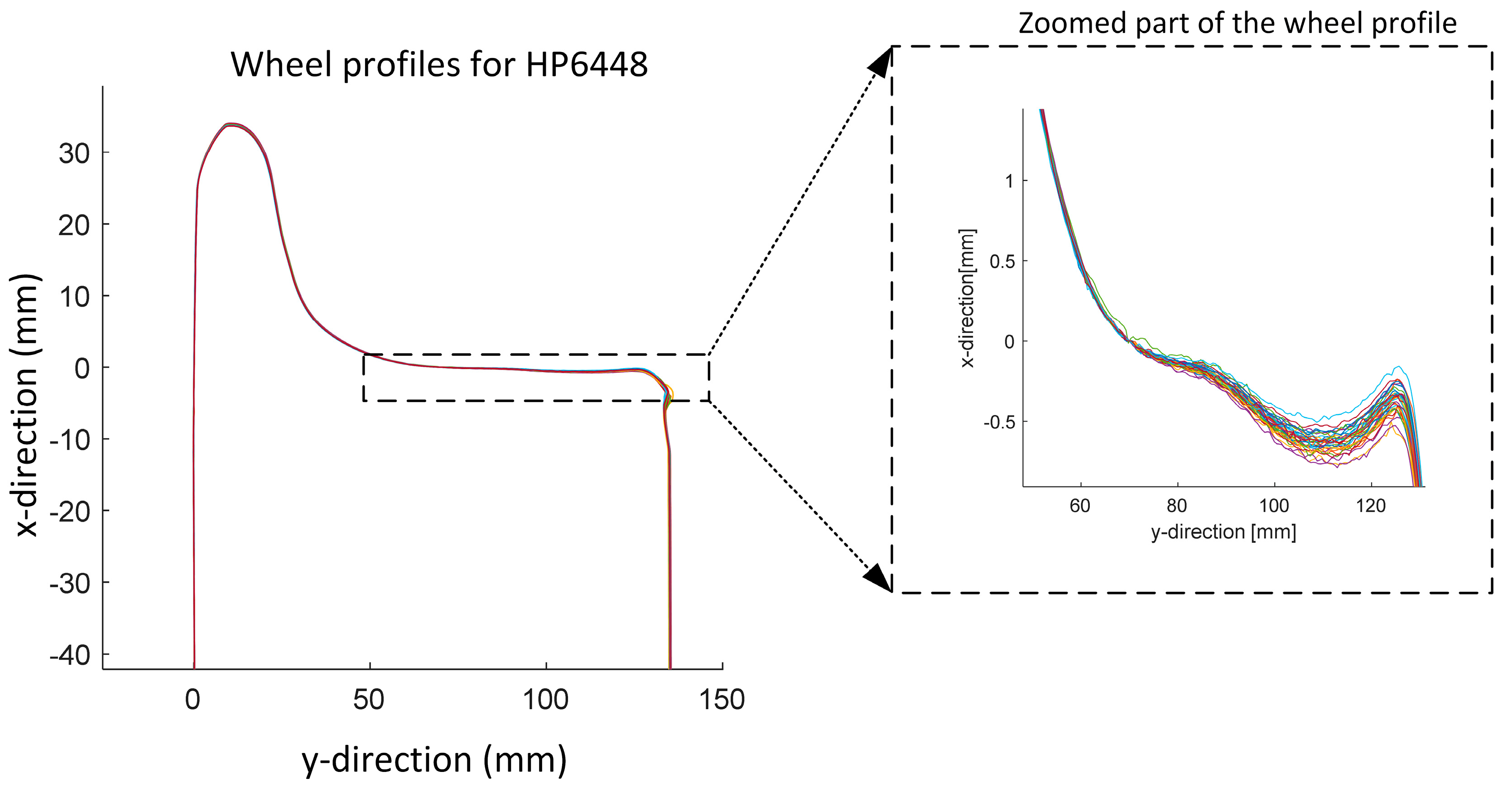
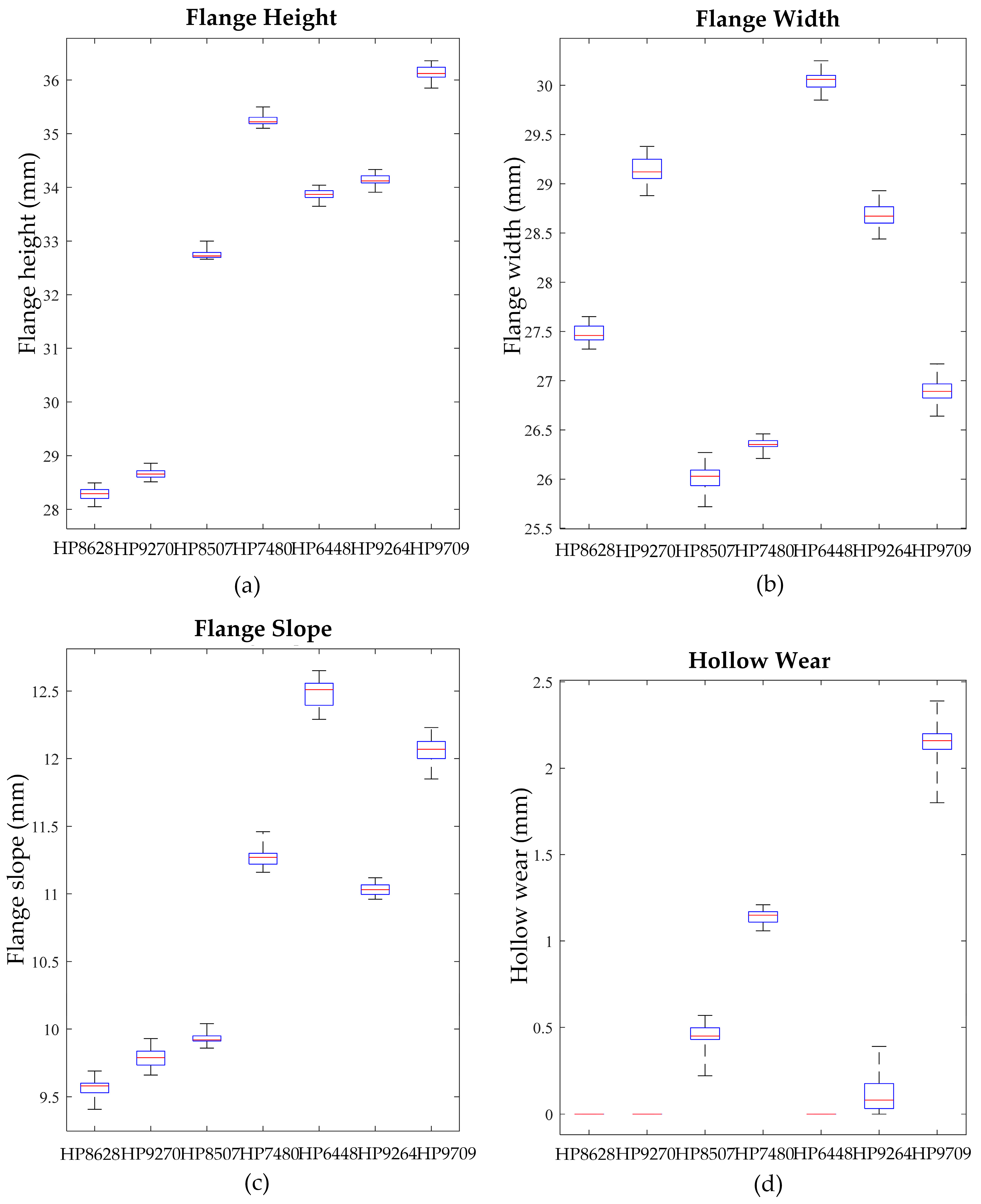
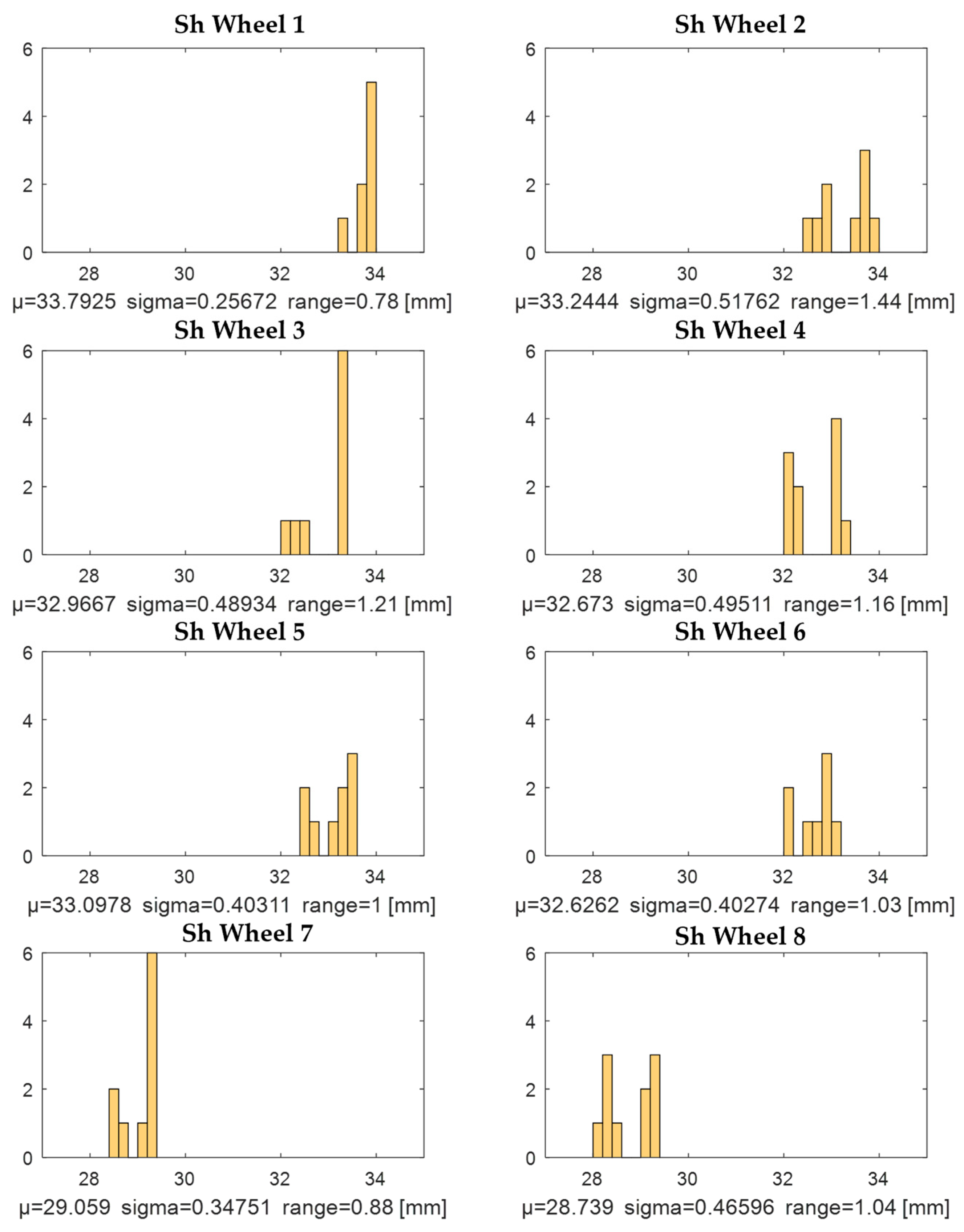
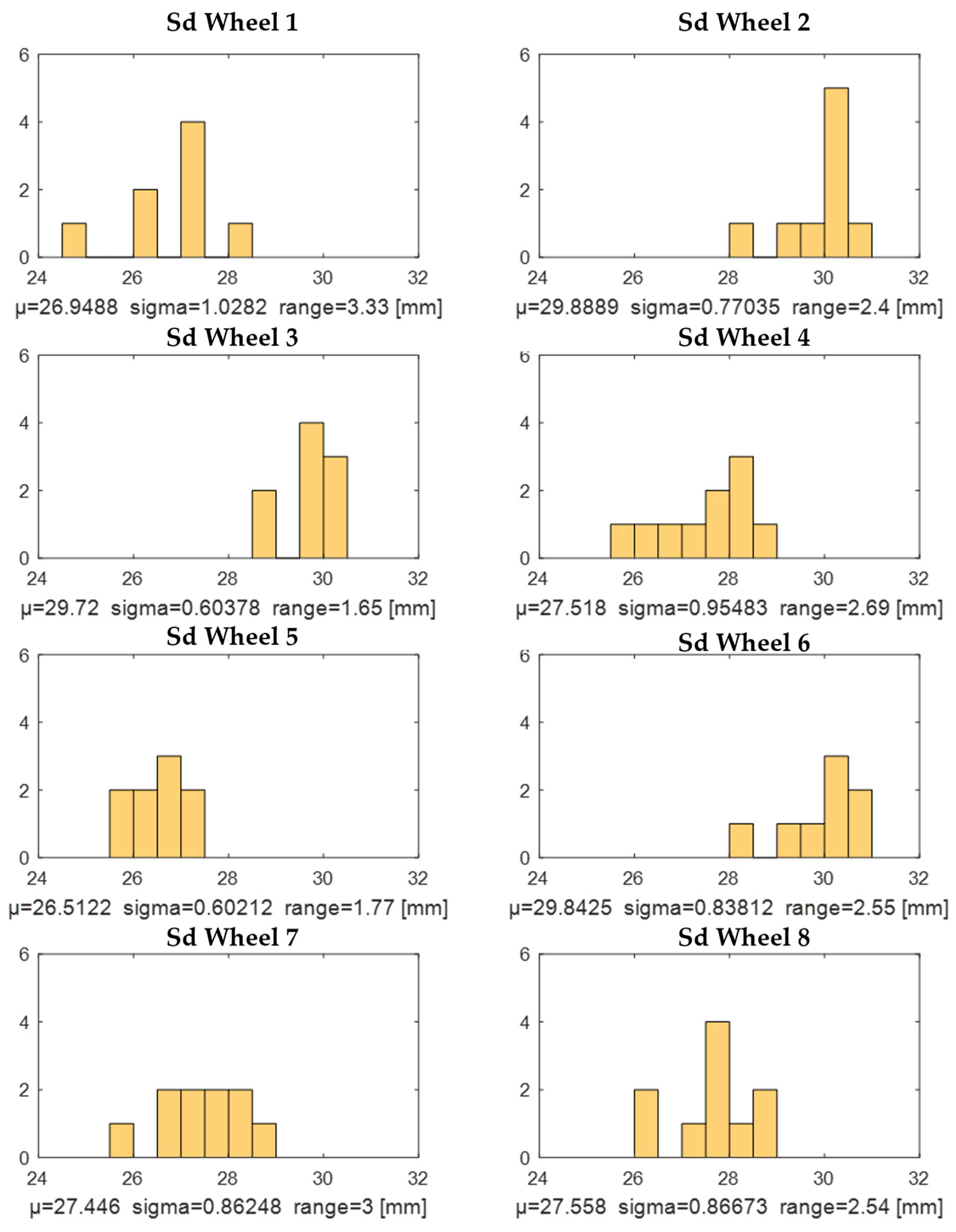
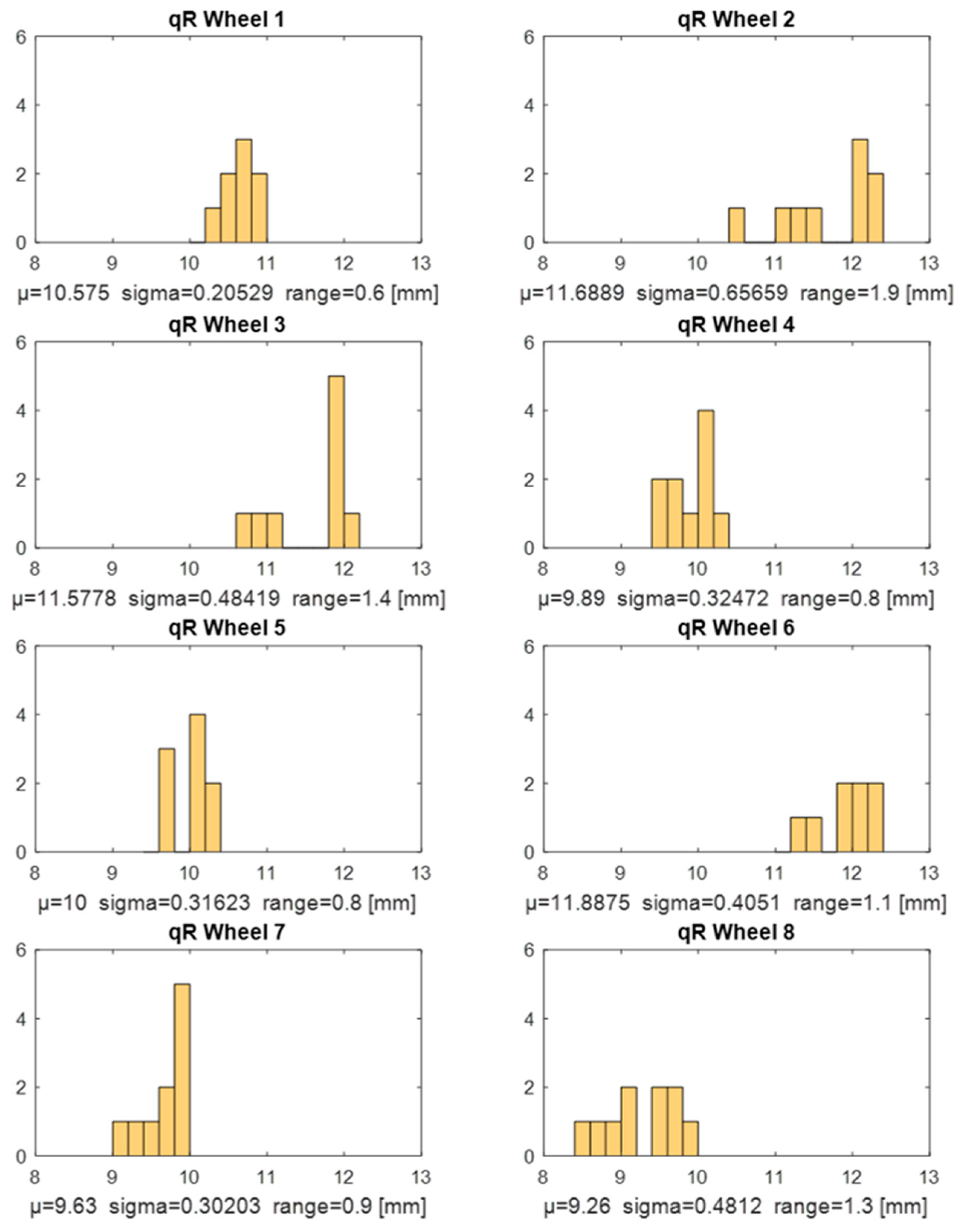
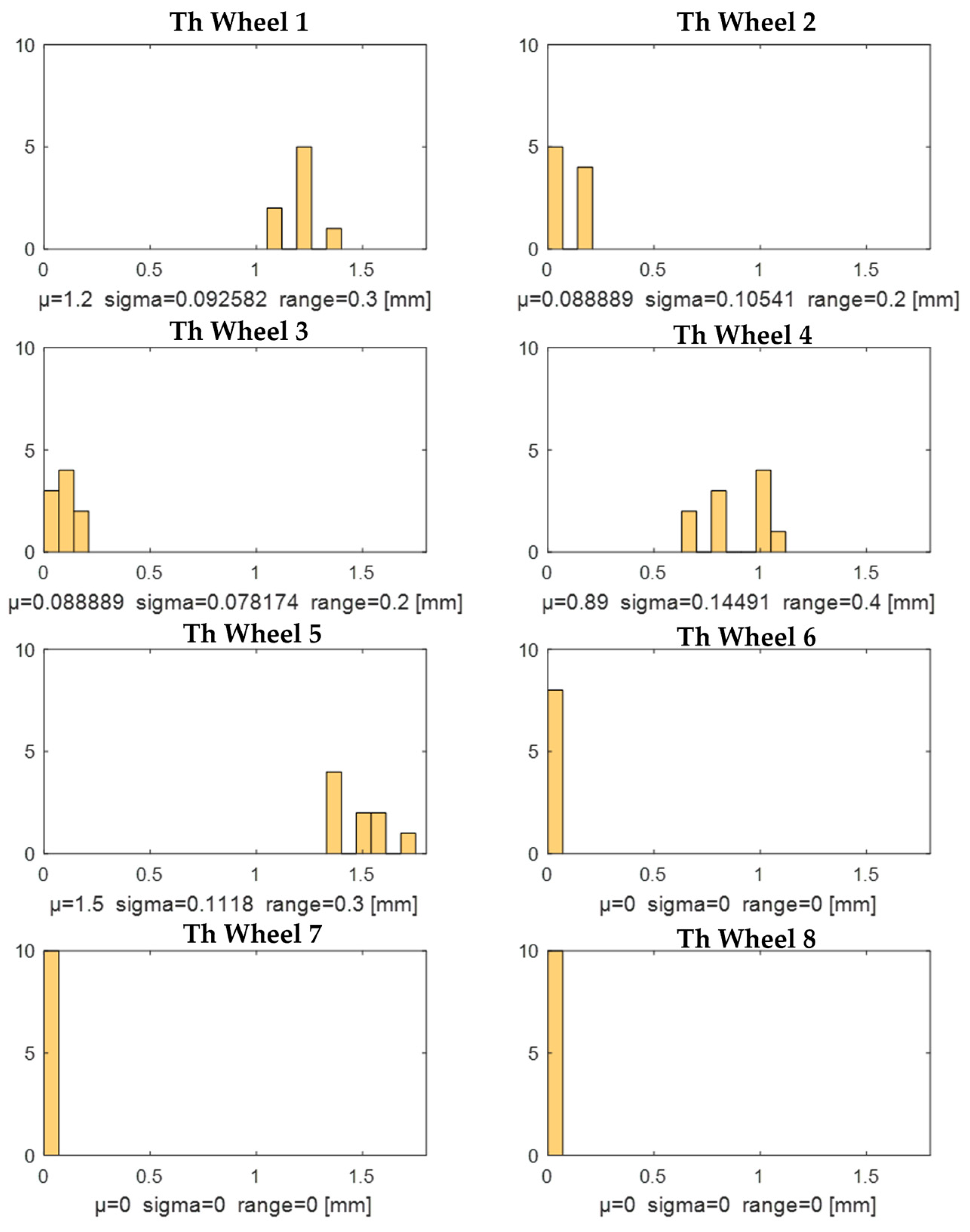
| Wheelset ID | Age (km) | Measurements |
|---|---|---|
| HP8628 | 0 | 35 |
| HP9270 | 0 | 35 |
| HP8507 | 237,832 | 35 |
| HP7480 | 315,740 | 35 |
| HP6448 | 317,125 | 35 |
| HP9264 | 409,522 | 35 |
| HP9709 | 409,522 | 35 |
| Wheel Number | Measurements |
|---|---|
| Wheel 1 | 8 |
| Wheel 2 | 9 |
| Wheel 3 | 9 |
| Wheel 4 | 10 |
| Wheel 5 | 9 |
| Wheel 6 | 9 |
| Wheel 7 | 10 |
| Wheel 8 | 10 |
| Parameter | Operator 1 | Operator 2 | Operator 1 and 2 | ||||
|---|---|---|---|---|---|---|---|
| µ1 (mm) | σ1 (mm) | µ2 (mm) | σ2 (mm) | µ3 (mm) | σ3 (mm) | 100 × 3/µ3 | |
| Sh | 35.122 | 0.002996 | 35.039 | 0.001409 | 35.0805 | 0.00220 | 0.00628 |
| Sd | 26.348 | 0.001876 | 26.293 | 0.002681 | 26.3205 | 0.00228 | 0.00866 |
| qR | 11.197 | 0.000921 | 11.159 | 0.000789 | 11.1780 | 0.00086 | 0.00765 |
| Th | 1.181 | 0.000459 | 1.195 | 0.000845 | 1.1880 | 0.00065 | 0.05488 |
| Wheel Id | Mean (mm) | Standard Deviation (mm) | Range (mm) | |||||||||
|---|---|---|---|---|---|---|---|---|---|---|---|---|
| Sh | Sd | qR | Th | Sh | Sd | qR | Th | Sh | Sd | qR | Th | |
| HP8628 | 28.283 | 27.486 | 9.564 | 0 | 0.114 | 0.091 | 0.059 | 0 | 0.440 | 0.330 | 0.280 | 0 |
| HP9270 | 28.267 | 29.142 | 9.783 | 0 | 0.086 | 0.131 | 0.0628 | 0 | 0.350 | 0.500 | 0.270 | 0 |
| HP8507 | 32.757 | 26.013 | 9.934 | 0.450 | 0.085 | 0.110 | 0.041 | 0.067 | 0.340 | 0.550 | 0.180 | 0.350 |
| HP7480 | 35.243 | 26.352 | 11.267 | 1.144 | 0.088 | 0.057 | 0.063 | 0.043 | 0.440 | 0.580 | 0.300 | 0.400 |
| HP6448 | 33.867 | 30.052 | 12.479 | 0 | 0.094 | 0.093 | 0.104 | 0 | 0.390 | 0.400 | 0.360 | 0 |
| HP9264 | 34.141 | 28.684 | 11.033 | 0.118 | 0.100 | 0.099 | 0.044 | 0.102 | 0.420 | 0.490 | 0.160 | 0.390 |
| HP9709 | 36.138 | 26.893 | 12.065 | 2.148 | 0.121 | 0.121 | 0.092 | 0.105 | 0.510 | 0.530 | 0.380 | 0.590 |
Disclaimer/Publisher’s Note: The statements, opinions and data contained in all publications are solely those of the individual author(s) and contributor(s) and not of MDPI and/or the editor(s). MDPI and/or the editor(s) disclaim responsibility for any injury to people or property resulting from any ideas, methods, instructions or products referred to in the content. |
© 2023 by the authors. Licensee MDPI, Basel, Switzerland. This article is an open access article distributed under the terms and conditions of the Creative Commons Attribution (CC BY) license (https://creativecommons.org/licenses/by/4.0/).
Share and Cite
Rantatalo, M.; Chandran, P.; Thiery, F.; Odelius, J.; Gustafsson, C.; Asplund, M.; Kumar, U. Evaluation of Measurement Strategy for Track Side Monitoring of Railway Wheels. Appl. Sci. 2023, 13, 5382. https://doi.org/10.3390/app13095382
Rantatalo M, Chandran P, Thiery F, Odelius J, Gustafsson C, Asplund M, Kumar U. Evaluation of Measurement Strategy for Track Side Monitoring of Railway Wheels. Applied Sciences. 2023; 13(9):5382. https://doi.org/10.3390/app13095382
Chicago/Turabian StyleRantatalo, Matti, Praneeth Chandran, Florian Thiery, Johan Odelius, Christian Gustafsson, Mathias Asplund, and Uday Kumar. 2023. "Evaluation of Measurement Strategy for Track Side Monitoring of Railway Wheels" Applied Sciences 13, no. 9: 5382. https://doi.org/10.3390/app13095382
APA StyleRantatalo, M., Chandran, P., Thiery, F., Odelius, J., Gustafsson, C., Asplund, M., & Kumar, U. (2023). Evaluation of Measurement Strategy for Track Side Monitoring of Railway Wheels. Applied Sciences, 13(9), 5382. https://doi.org/10.3390/app13095382







